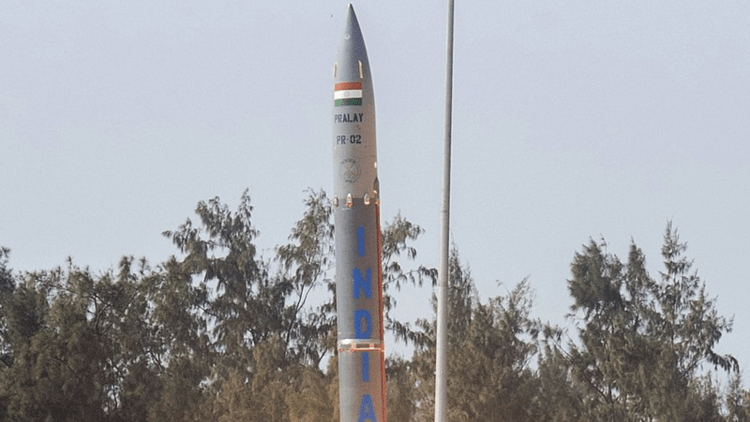In a series of successful tests, India has demonstrated its growing prowess in missile technology by developing and testing the “Pralay” surface-to-surface short-range ballistic missile (SRBM).
Launched from the Abdul Kalam Island off the Odisha coast, the Pralay missile, developed by the Defence Research and Development Organisation (DRDO), has showcased its potential to meet the country’s defense requirements, particularly along the borders with China and Pakistan.
Pralay SRBM: Development and Strategic Significance
The Pralay missile, conceived and developed by the DRDO, stands as a testament to India’s commitment to advancing its defense capabilities.
With its successful test-firing, the missile met all its mission objectives, marking a significant milestone in India’s missile development program.
The DRDO’s emphasis on meeting defense requirements along the borders underscores the strategic significance of the Pralay missile in the country’s security architecture.
Technical Specifications and Capabilities
According to reports, the Pralay is a short-range, surface-to-surface missile with a range of 350-500 km and a payload capacity ranging from 500-1,000 kg. This solid-fuel battlefield missile is based on the Prithvi Defence Vehicle, showcasing a robust foundation for its development.
The choice of solid fuel enhances the missile’s agility and responsiveness, making it well-suited for quick reaction scenarios.
The missile’s specifications position it for deployment along the Line of Actual Control (LAC) and Line of Control (LoC), addressing India’s border regions’ specific geographical and strategic requirements.
In a series of successful tests, India has demonstrated its growing prowess in missile technology by developing and testing the “Pralay” surface-to-surface short-range ballistic missile (SRBM).
Launched from the Abdul Kalam Island off the Odisha coast, the Pralay missile, developed by the Defence Research and Development Organisation (DRDO), has showcased its potential to meet the country’s defense requirements, particularly along the borders with China and Pakistan.
Pralay SRBM: Development and Strategic Significance
The Pralay missile, conceived and developed by the DRDO, stands as a testament to India’s commitment to advancing its defense capabilities.
With its successful test-firing, the missile met all its mission objectives, marking a significant milestone in India’s missile development program.
The DRDO’s emphasis on meeting defense requirements along the borders underscores the strategic significance of the Pralay missile in the country’s security architecture.
Technical Specifications and Capabilities
According to reports, the Pralay is a short-range, surface-to-surface missile with a range of 350-500 km and a payload capacity ranging from 500-1,000 kg. This solid-fuel battlefield missile is based on the Prithvi Defence Vehicle, showcasing a robust foundation for its development.
The choice of solid fuel enhances the missile’s agility and responsiveness, making it well-suited for quick reaction scenarios.
The missile’s specifications position it for deployment along the Line of Actual Control (LAC) and Line of Control (LoC), addressing India’s border regions’ specific geographical and strategic requirements.
The Pralay missile, with its versatile payload capacity and range, is designed to provide a flexible and effective defense mechanism in these critical areas.
Comparative Analysis with Global Counterparts
The Pralay missile has drawn comparisons with China’s Dong Feng 12 and Russia’s Iskander, which is particularly noteworthy in light of the latter’s utilization in the ongoing conflict in Ukraine.
This comparison underscores the global competitiveness in missile development and highlights India’s focus on creating a missile system that can rival or surpass those of its regional counterparts.
In terms of specifications, the Pralay aligns closely with the Iskander-M quasi-ballistic missile.
Both missiles have a range of 350-500 km, possess similar accuracy with a Circular Error Probability (CEP) of around 10 meters, and feature terminal guidance systems.
The Pralay’s reported capability to release decoys and its jet vane system for thrust vector control during terminal maneuvering further enhance its defensive capabilities, making it a formidable force on the modern battlefield.
Geopolitical Context and Regional Dynamics
The Pralay missile’s successful test comes at a crucial time when India faces complex geopolitical challenges along its borders, particularly with China and Pakistan.
The strategic deployment of the missile along the LAC and LoC reflects India’s proactive approach to safeguarding its territorial integrity and addressing evolving threats.
The inclusion of Pakistan’s tactical ballistic missiles in the regional defense dynamics emphasizes the need for India to continuously innovate and strengthen its defense capabilities.
The acquisition plans for around 120 Pralay ballistic missiles, as reported by ANI, further signal India’s commitment to enhancing its defense preparedness and achieving a credible deterrent against potential adversaries.
Technological Innovations and Future Prospects
The Pralay missile’s technological features, including its jet vane system and radar-transparent radome for terminal homing, showcase India’s commitment to advancing missile technology.
The ability to switch to a quasi-ballistic trajectory and perform terminal maneuvers makes the Pralay a challenging target for adversary air defense systems.
Its solid propellant rocket motor and weight characteristics further contribute to its effectiveness.
Looking ahead, the Pralay missile’s successful development and imminent induction into the Indian armed forces mark a crucial step in bolstering the country’s defense capabilities.
The missile’s mobility, with land-mobile quick reaction systems, enhances its strategic flexibility, allowing for rapid deployment in response to emerging threats.
Pralay short-range ballistic missile during its recent test launch on Abdul Kalam Island off the coast of Odisha (Screengrab via X)
~
India’s successful test of the Pralay missile is a testament to the country’s growing capabilities in missile technology and defense innovation.
The missile’s technical specifications, strategic deployment along the borders, and comparisons with global counterparts position it as a key player in the evolving dynamics of regional security.
As India continues to face complex challenges along its borders, developing and deploying advanced missile systems like the Pralay become imperative for maintaining a robust defense posture.
The geopolitical context, regional dynamics, and the evolving nature of warfare underscore the importance of technological innovation and strategic foresight in safeguarding national interests.
In the ever-changing landscape of global security, India’s Pralay missile emerges not just as a weapon system but as a symbol of the nation’s commitment to technological prowess and safeguarding its sovereignty.
As the missile prepares for induction into the Indian armed forces, it marks a significant stride toward securing the nation’s future in an increasingly complex and dynamic geopolitical environment.



